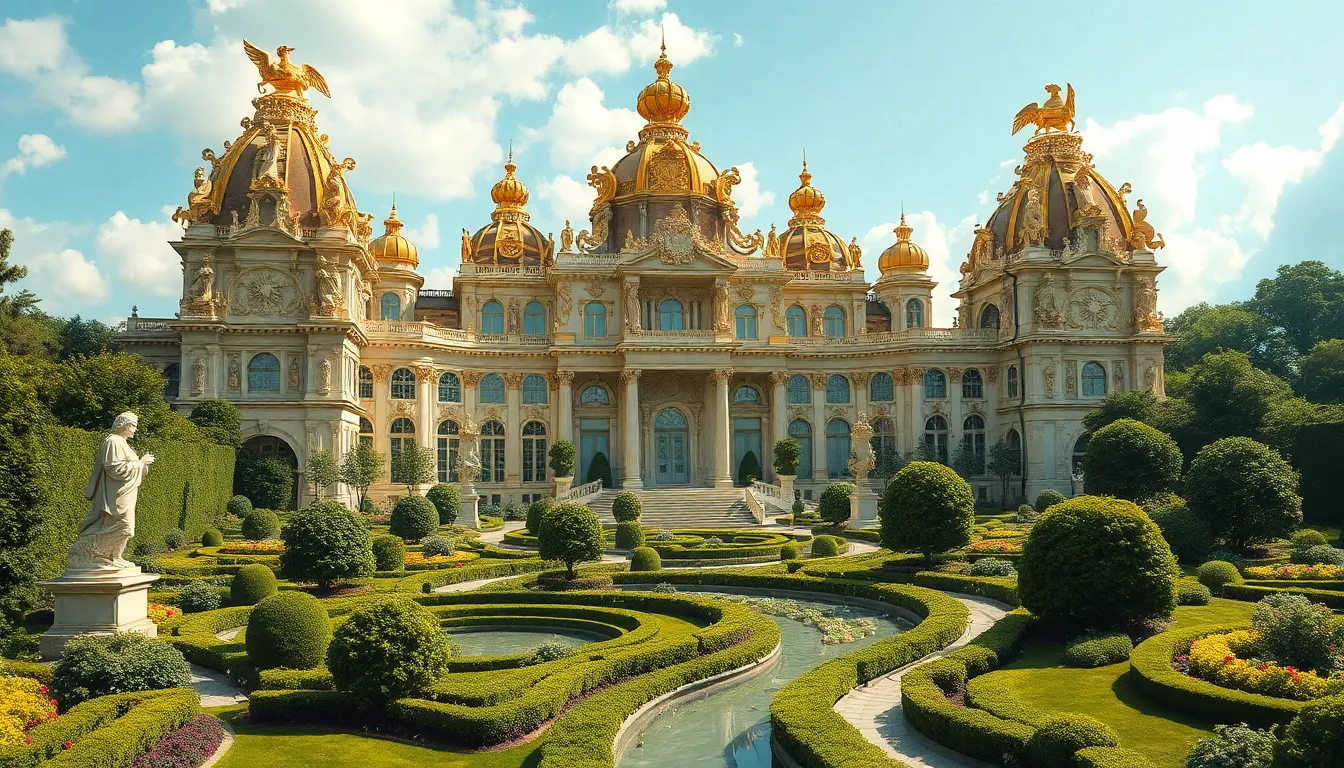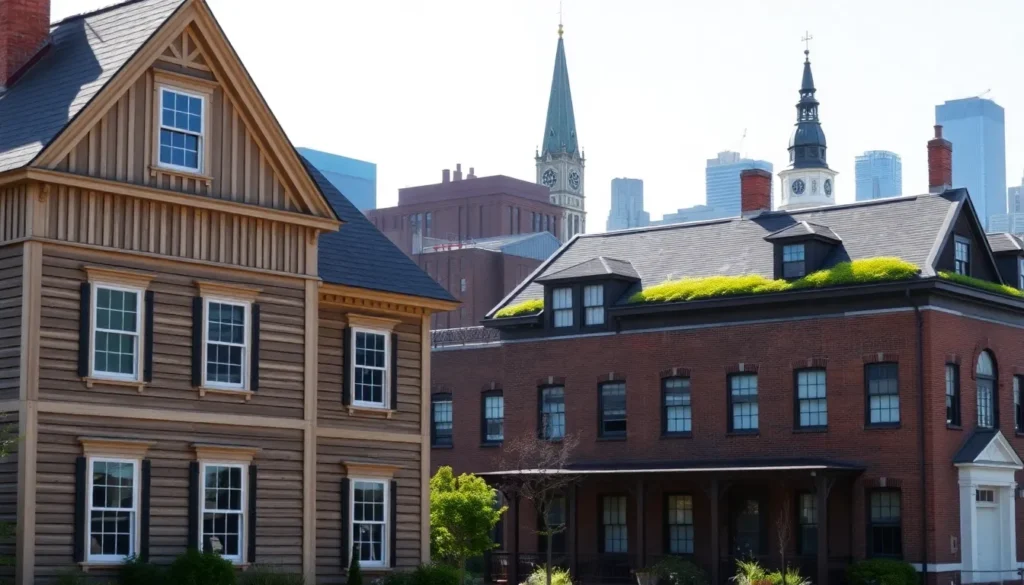Table of Contents
ToggleBaroque architecture is like the flamboyant cousin at a family reunion—bold, extravagant, and impossible to ignore. Emerging in the late 16th century, this style took the art world by storm, proving that less is definitely not more. Think grandiose structures, swirling forms, and a splash of drama that makes even the most stoic observer gasp in awe.
Overview of Baroque Architecture
Baroque architecture represents a significant evolution in architectural design from the late 16th century onward. Characterized by dramatic use of light and shadow, Baroque structures create immersive experiences for viewers. Architects emphasized bold forms, resulting in elaborate facades and sweeping curves that evoke a sense of movement and dynamism.
Grand scale plays a vital role in Baroque buildings. Common elements include enormous domes, intricate ornamentation, and expansive interiors that often feature detailed frescoes. The use of symbolism is prevalent; these structures often convey religious themes, reflecting the church’s power and influence during this period.
Key examples of Baroque architecture include St. Peter’s Basilica in Vatican City, designed by architects like Michelangelo and Bernini. The Palace of Versailles in France also exemplifies Baroque splendor with its lavish gardens and opulent interiors.
Design principles focus on unity and coherence. Architects integrated various disciplines, including sculpture and painting, to enhance the overall effect. Elements like columns and pilasters often create a harmonious relationship among the different parts of the structure.
Baroque architecture flourished in various regions, including Italy, France, and Germany. Each locality put its unique touch on the style, leading to diverse interpretations and adaptations. In Italy, the style remained faithful to its origins, while France embraced a more refined version.
Overall, Baroque architecture showcases an era of innovation and creativity that significantly influenced subsequent architectural movements. The fusion of art and architecture during this period established a legacy that continues to inspire builders and designers today.
Key Characteristics of Baroque Architecture

Baroque architecture captivates with its distinctive features and elaborate design elements. This style’s grandeur and intricacy leave a lasting impression on viewers.
Use of Ornamentation
Ornamentation stands as a hallmark of Baroque architecture. Architects utilized intricate details like sculpted figures, friezes, and flourishes to enhance buildings. Churches and palaces commonly displayed lavish decorations that conveyed wealth and power. Gold leaf frequently highlighted key areas, creating a stunning visual contrast. Artistic elements often included mythological themes or religious iconography, reflecting the era’s cultural values. These decorative techniques created immersive environments that drew spectators’ attention, inviting them to explore every corner of the structure. Overall, ornamentation in Baroque buildings emphasizes the style’s emotional impact and visual splendor.
Dynamic Shapes and Forms
Dynamic shapes and forms define Baroque architecture’s unique aesthetic appeal. Architects embraced curves, sweeping lines, and bold projections within their designs. Buildings often featured elaborate domes and grand facades that inspired movement. This emphasis on curvilinear design created a sense of fluidity and energy, contrasting with the rigidity of prior architectural styles. Courtyards and gardens incorporated flowing pathways, encouraging guests to experience a journey through the space. Architectural elements emphasized light and shadow, enhancing the drama of the structures. This innovative approach established a distinct visual language that resonated across Europe, influencing countless structures and movements that followed.
Historical Context
Baroque architecture flourished during the late 16th to mid-18th centuries, reflecting significant cultural changes in Europe. This style emerged alongside the Counter-Reformation, where the Catholic Church sought to inspire awe and devotion through grand imagery.
Origins of Baroque Architecture
Baroque architecture originated in Italy around the late 1500s. It evolved from the Renaissance, emphasizing emotional expression through exaggerated forms. Rome played a crucial role, serving as an artistic hub where architects experimented with light and space. The style’s connection to the Catholic Church is evident, as it aimed to convey religious fervor. Key themes also included theatricality and spectacle, demonstrating the power and significance of religious narratives.
Influential Architects
Several architects significantly shaped Baroque architecture. Gian Lorenzo Bernini stands out for his work on St. Peter’s Basilica, creating both structural and artistic harmony. Francesco Borromini introduced unique shapes and intricate details in buildings like San Carlino alle Quattro Fontane, emphasizing dynamic forms. Other notable figures include Nicolas Saviés and Louis Le Vau, who adapted Baroque principles in France, blending them with local styles. Their contributions helped define the architectural landscape and solidify Baroque as a distinct movement across Europe.
Major Examples of Baroque Architecture
Baroque architecture features many iconic structures that exemplify its grandeur and complexity. Each notable building showcases distinct elements that define this artistic style.
Notable Buildings
St. Peter’s Basilica in Vatican City stands as a prime example of Baroque brilliance, designed by architects like Gian Lorenzo Bernini. The façade’s grandeur and the dome’s enormous scale create an awe-inspiring atmosphere. The Palace of Versailles in France attracts visitors with its lavish gardens and opulent interiors, reflecting the wealth of the French monarchy. Another significant structure is the Würzburg Residence in Germany, known for its stunning frescoed ceilings and extravagant ornamentation.
Regional Variations
Italy served as the birthplace of Baroque architecture, influencing many subsequent designs. In contrast, France’s adaptation emphasized elegance and symmetry, seen in buildings like the Château de Maisons. Germany, meanwhile, highlighted intricate details and vibrant colors, particularly in structures such as the Residenz Würzburg. Each region contributed unique characteristics, showcasing Baroque’s diverse interpretations across Europe.
Impact of Baroque Architecture
Baroque architecture significantly influenced subsequent architectural movements and design principles, creating a lasting legacy that remains evident today.
Influence on Later Styles
Influence on later styles manifests in various architectural forms, particularly Neoclassicism, which emerged in reaction to Baroque’s excesses. Characteristics like grandeur and symmetry carried over from Baroque’s dramatic emphasis on space and ornamentation. Many architects adopted Baroque’s use of light and shadow, enhancing visual interest in their designs. Similarly, the Romantic and Beaux-Arts movements drew inspiration from the ornate details and complex compositions of Baroque structures. Notable examples include the Paris Opera House, which reflects Baroque elements with its sweeping curves and lavish decorations. This evolution illustrates how Baroque architecture laid a foundation for future stylistic developments.
Baroque in Contemporary Design
Baroque influence continues in contemporary design, with modern architects occasionally incorporating Baroque elements in their work. Contemporary structures often take inspiration from Baroque’s dynamic forms and intricate detailing, using modern materials to achieve similar effects. High-profile buildings, such as the Walt Disney Concert Hall in Los Angeles, showcase curves reminiscent of Baroque’s fluid lines. Some interior designers also revive Baroque styles by integrating ornamental features and bold color schemes into modern settings. This blend of old and new highlights the adaptability of Baroque principles in today’s architectural landscape.
Baroque architecture remains a testament to the power of creativity and innovation. Its dramatic forms and intricate details continue to inspire awe and admiration. The style’s ability to convey emotion and grandeur has left an indelible mark on architectural history.
As contemporary designers draw from Baroque principles, the legacy of this extraordinary movement endures. Its influence can be seen in modern structures, proving that the essence of Baroque architecture transcends time. The captivating beauty and rich symbolism of Baroque buildings ensure they will always hold a special place in the hearts of those who appreciate art and architecture.


